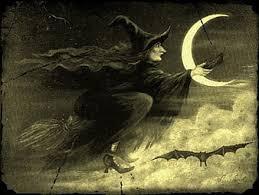I worked at an hotel in Stow on the Wold for a short time in the 1980s. One day I came across a booklet in a gift shop that told of The Cotswold Witches. I have always been very drawn to issues supernatural so I was intrigued.
On reading, I discovered that the women acused of witchcraft were often simple healers or knowledgble women who were discriminated against by less intelligent people. There were however some suprising facts. As we all know, in stories witches are typecast as ugly creatures who flew on broomsticks. Actually many of these women made a poulltice from belladonna flowers and rubbed it on thier skin. This had an hallucinagenic effect which made them feel as if they were flying.The poison also affected thier skin clour, making them appear gray and haggard. Strange but true.

Witches have always occupied a curious place within rural communities. They were blamed for bad luck or illness, but at the same time they were respected for their ability to heal, find stolen goods, and tell the future.
Cotswold witches Catherine Huxley, Bevil Blizard and Ellen Hayward are classic examples of this ambivalent attitude, with Catherine Huxley (c. 1612-1652), known as ‘the witch of Evesham’, being a particularly tragic case.
According to an account published in 1691, Catherine Huxley was being tormented by a group of children who were throwing stones at her and calling her a witch. They ran away when she shouted at them, but Mary Ellins (aged nine) got left behind and Catherine said to her, “you shall have enough stones in your stomach.”
Mary began to “void stones by the urinary passages,” and experienced the “most grievous pains in her Back and Reins,” which are “like the pricking of Pins.” After passing some 80 stones, “some plain pebbles, some plain flints, some very small, and some about an ounce weight,” her parents claimed that Catherine had cursed their daughter. Similar stones being found by the side of Catherine’s bed was evidence enough for her to be charged as a witch, and she was executed by hanging.
In contrast to poor Catherine, Bevil Blizard (1742-1836), who was also known as the Necromancer of Winchcombe or Blizard the Wizard, enjoyed the respect of his community. He was widely believed to possess supernatural powers and the story is told of how he hurriedly left work in the fields one day, telling his workmates that he knew that his henhouse was being robbed. To the astonishment of those left behind, his scythe continued to cut the hay after he dashed off.
He was also able to find stolen objects and identify thieves, although on one occasion, instead of finding the stolen item (a scythe), he replaced it with his own and told the victim that the thief would not prosper. Not only did the replacement scythe work better than the stolen item, the thief, identified by Blizard as Anthony Martin, suffered from all his joints freezing up.
Falling somewhere between Catherine Huxley and Bevil Blizard is Ellen Hayward (70), ‘the wise woman of Cinderford,’. Unlike Catherine, she was not blamed with causing death; instead, in 1906, she appeared in the Petty Sessions charged, “with unlawfully using… certain craft, or means, or device, by pretended witchcraft to deceive and impose upon James Davis.”
James Davis, a farmer who lived near Worcester, had ill-luck with his livestock. His cows refused to milk, the pigs became unwell, and a new pig he bought at market began to fail. He consulted a ‘travelling woman’ who told him that the animals were being charmed and that there was a spell on them. Believing Ellen Hayward to be a witch possessed of supernatural abilities, Davis thought she would be the ideal person to remove the spell on his ailing pig.
And so, between November 1905 and February 1906, Davis paid Hayward half a crown, then five shillings, then 10 shillings, and finally a sovereign, seeking her advice on how to deal with the bewitchment. He made several trips to her home in the Forest of Dean and on his final visit at the end of February 1906, he accused her of putting a spell on him. She denied it, and the matter ended up in the Petty Sessions, where the magistrates dismissed the case. Ellen Hayward was lucky because the most common outcome in cases of ‘pretence’ of witchcraft was a fine or custodial sentence.
Although the Witchcraft Act of 1735 abolished the death penalty for witchcraft, fear of witches was still widespread. The murder of Ann Tennant in Long Compton reminds us that many believed a witch’s curse could be undone if she could be made to bleed.
It is unlikely that Ann was actually a witch, but one of her neighbours, James Haywood, was terrified of witchcraft and, on September 15, 1875, he was returning home from working in the harvest fields when he saw Ann leaving the village shop. He attacked her using his hayfork, inflicting such serious injuries that she died a few hours later.
During his trial he pled not guilty, saying, “I be sorry I hurt the woman, but she tormented me for a long time in witchcraft.” The jury returned a verdict of, “not guilty on the grounds of insanity,” and committed him to Broadmoor Criminal Lunatic Asylum, where he remained until his death on June 23, 1890, aged 59.
Thanks for reading. Adele
Email ThisBlogThis!Share to TwitterShare to Facebook